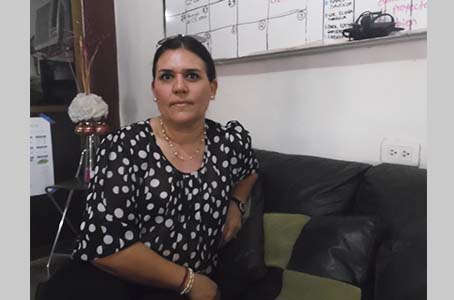Interview: Alma Gpe. Gaxiola Noriega Director of General Angel Flores Elementary School.

Originally from La Palma, Villa Ángel Flores; Graduated from the Bachelor’s Degree in Primary Education and with a Master’s and Ph.D. in Human Development oriented to Pedagogy, Alma Gaxiola Noriega already has 21 years of service in the education sector and 13 years at the head of the team of General Ángel Flores Primary School in Community of Lo de Sauceda, which was pilot in the integration of migrant children.
- Could you talk a bit about the process that the school lived to become an elementary school?
At first the primary was multigrade – bidocente, that is, I was in charge of management and three degrees and another teacher supported with the rest of the salons; And it worked in this way because the number of students we had was very low.
At that time, at the side of the school were facilities where, with the support of the National Council for Educational Development (CONAFE), classes were given to migrant children. For me, incorporating these children represented an opportunity to increase enrollment, which would bring great overall benefits, and the project was presented to Ms. Dora Ochoa, Human Resources Manager of Agricola Belher.
It was in the school year 2001-2002 that we began integrating migrant children into primary school.
First, we worked on the literacy of children who could not read or write, forming a new hall of 1st year and joined a new teacher.
As the number of students increases, from being a school with two teachers, we have a teacher for the 1st year, a teacher for 2nd year, a teacher for 3rd and 4th year and a teacher for 5th and 6th, and I the direction.
There was so much demand that before the end of the school year, parents returning to Guerrero and Veracruz already had the quota removed and even leaving the requested documents.
That was how we managed to make up the six rooms, with a teacher for each one of them and we have gradually incorporated personnel to become the team we are today.
- What was the main motivation to start with this project?
I always wonder why when we have a general State Government school, migrant children have to attend separate schools. Why create a school for them if there is a school for all ?.
On the other hand, not only would we benefit them, at the end of the day the children of the community would have a better attention to have a teacher for each of the grades.
- What were the main challenges you faced during this process?
Mainly change habits, integration and combat educational lag.
At first it was a denial on the part of the children, both community and migrants. To be able to integrate, we name a child from the “tutor” community of a migrant child, set up teams and try to keep them varied and even do the same with the parents.
This and other integration activities are repeated year after year.
- How has the acceptance of this project by the parents of migrant families evolved?
At first, because of their culture, they were a bit closed to this idea. Once they began to notice the changes of habit, especially of the appearance of the children who joined the school, they were a little more receptive to this idea.
At first, they saw it as a kindergarten and there was no commitment on their part but little by little, through a process of awareness, we explain that in a way they can offer their children a better life and education is the primary thing.
It was difficult because they are families that come for seasons and did not even want to give us official documentation, which is why we request to provide documentation to these children before the end of the school year.
Today we have a program throughout the school year through which we involve more actively the parents and we have managed to realize that it is not only a kindergarten, but a school and that as we demand results from us, as a school we must receive the same commitment from them.
- And from the children?
I want you to know that we do not accept more children because our infrastructure no longer allows us, but the demand is very high.
Thanks to the results obtained, the parents prefer to attend this school. And this, as I said, is a year-to-year job. Awareness programs are re-programmed, tutors are appointed, values, habits, etc. are reinforced.
6 Somehow this school was pilot and now many others have integrated migrant children, what do you think about it?
That is the primary goal, to eliminate schools for migrants. I think that if children are integrated into the regular schools they will be better served and, in case they change places or agricultural fields, they will arrive with better bases.
For me, this project is a personal achievement, and I never had the objective of obtaining a role that would establish me as a pioneer, but the true integration of children into the community and eradicate the discrimination that was promoted.
- How do you think the model of care for migrant children should be at the national level?
It must be truly inclusive, eliminating the myriad of bureaucratic programs. Education should be general and children should be free to attend schools that best meet their needs and offer them better opportunities for growth and training.
On the one hand the reforms affirm that it is intended to train the children to have the tools you need to integrate into society and in practice the opposite is done; Programs that serve children separately do not allow them to develop in the environment in which they relate.
- Anything else you want to add?
I appreciate you taking our work into account. We know we make mistakes but we are learning. I always tell my teachers: “If this school stands out I do not stand out, let’s all stand out.”


